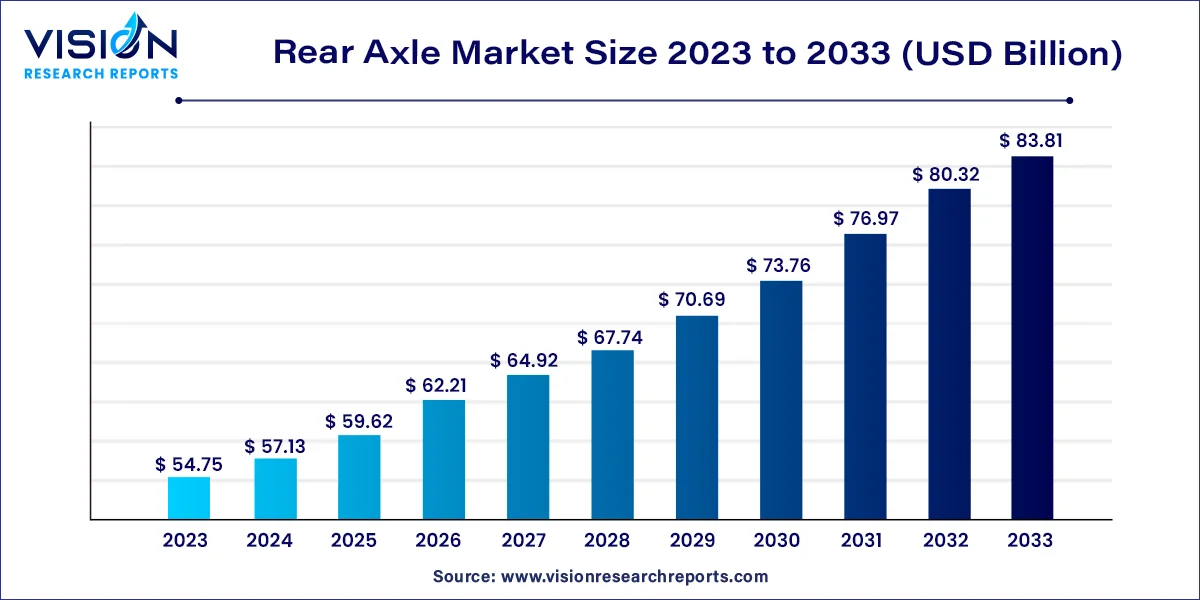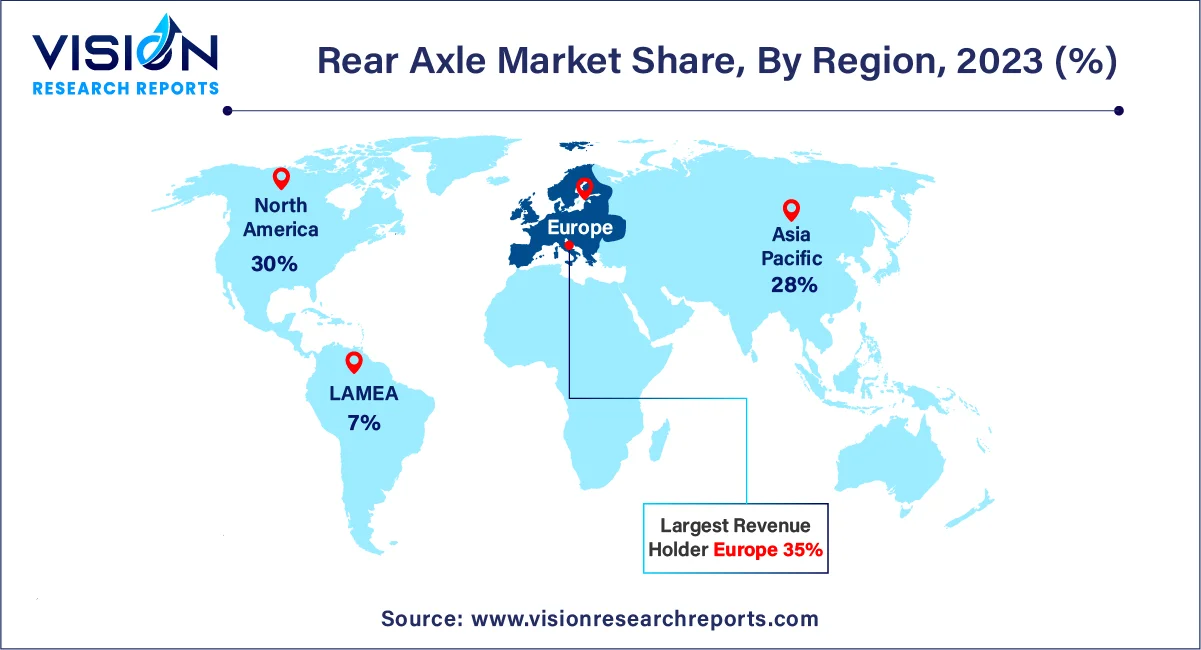The global rear axle market size was valued at USD 54.75 billion in 2023 and it is predicted to surpass around USD 83.81 billion by 2033 with a CAGR of 4.35% from 2024 to 2033. The rear axle market plays a crucial role in the automotive and transportation sectors, serving as a key component in vehicle dynamics and performance. As the automotive industry evolves, particularly with the rise of electric vehicles (EVs) and advancements in vehicle technology, the rear axle market is witnessing significant changes.

The growth of the rear axle market is driven by an increasing demand for vehicles, particularly in emerging markets, significantly boosts production levels, necessitating more rear axles. Additionally, the automotive industry's transition towards electric vehicles (EVs) is creating a demand for specialized rear axles designed to accommodate unique powertrains and weight distribution needs. The emphasis on enhancing vehicle performance, safety, and fuel efficiency is also prompting manufacturers to innovate and develop advanced axle designs that incorporate lightweight materials and smart technologies. Furthermore, the rise in commercial vehicle usage, driven by e-commerce and logistics, is contributing to the market's expansion, as these vehicles require robust and reliable rear axles for optimal performance.
In 2023, the Europe rear axle market held the largest share of the global rear axle market at 35%. The region's dominance is supported by its advanced automotive industry, with leading countries such as Germany, France, Italy, and the UK manufacturing high-quality vehicles that require sophisticated rear axles. Europe is also recognized for producing luxury cars and fostering innovations in rear axle technologies to enhance the driving experience.
The German rear axle market is expected to witness significant growth in the coming years, bolstered by the country’s strong manufacturing capabilities, especially in high-quality automotive parts production. German manufacturers are known for their stringent adherence to quality standards and regulations, employing rigorous controls to ensure the structural integrity of their rear axles.
In 2023, the North America rear axle market held a substantial share of the global rear axle market. This region has positioned itself as a technological frontrunner in the automotive sector, with significant investments in research and development driving advancements in rear axle performance and efficiency. Efforts focused on cost reduction have also reinforced the region's leadership in the rear axle market, ensuring ongoing growth and competitiveness.
The U.S. rear axle market dominated the North American market with a revenue share of 82.83% in 2023. The efficiency of the U.S. manufacturing industry in producing rear axles in large volumes satisfies both local and export demands. With a vast vehicle market and robust industry partnerships, American firms maintain a leading role in rear axle production.

The Asia Pacific rear axle market is projected to achieve the highest CAGR of 5.23% in the global rear axle market during the forecast period. Factors contributing to industry growth in this region include a booming automotive sector, increased demand for commercial vehicles, potential electric vehicle adoption, technological advancements, and government support for sustainable practices. Furthermore, environmental concerns are driving a shift towards electric vehicles in the region, creating demand for new rear axles compatible with electric drive systems.
The Chinese rear axle market is expected to expand rapidly in the coming years. The automotive sector in China has experienced substantial growth due to rising demand for passenger cars. This has led to numerous manufacturers establishing operations in the country, making China the largest rear axle market. The development of a strong supply chain network, facilitated by the establishment of automotive manufacturing bases, has significantly contributed to rear axle production, positioning China as a key player in the global rear axle market.
The drive axle segment led the global rear axle market in 2023, capturing a revenue share of 55%. Drive axles are essential for distributing power from the engine to the wheels, which is crucial for achieving optimal performance in both commercial and passenger vehicles. Recent advancements in design have enhanced the service life, strength, and reliability of drive axles, making them a preferred choice in the automotive industry for improving drive systems and overall vehicle performance.
Meanwhile, lift axles are projected to exhibit the highest CAGR of 4.63% during the forecast period. Their ability to enhance fuel efficiency by redistributing vehicle weight significantly boosts performance and fuel economy. As consumers increasingly prioritize safety and comfort, lift axles are gaining popularity, especially in heavy-duty or off-road applications, thereby driving demand for this technology.
In 2023, the economy vehicles segment commanded a significant share of the global rear axle market, with a revenue contribution of 36%. Economy vehicles focus on affordability, budget considerations, and return on investment (ROI), making them appealing to a broad consumer base. Our rear axles for these vehicles strike a balance between cost-effectiveness and performance, ensuring durability and efficiency. By effectively transferring torque from the wheels to the differential, these axles enhance overall fuel economy, aligning with environmentally friendly initiatives and boosting the demand for sustainable vehicles.
Luxury vehicles are anticipated to experience the fastest CAGR of 5.25% during the forecast period. Premium consumers demand superior safety, comfort, and performance in their luxury vehicles. High-quality rear axles equipped in these vehicles provide a smooth ride and improved safety, fulfilling these stringent standards. As the global luxury market expands due to rising disposable incomes and aspirational lifestyles, we are committed to developing innovative rear axle solutions that cater to the evolving requirements of this lucrative segment.
By Type
By Application
By Region
Chapter 1. Introduction
1.1. Research Objective
1.2. Scope of the Study
1.3. Definition
Chapter 2. Research Methodology
2.1. Research Approach
2.2. Data Sources
2.3. Assumptions & Limitations
Chapter 3. Executive Summary
3.1. Market Snapshot
Chapter 4. Market Variables and Scope
4.1. Introduction
4.2. Market Classification and Scope
4.3. Industry Value Chain Analysis
4.3.1. Raw Material Procurement Analysis
4.3.2. Sales and Distribution Channel Analysis
4.3.3. Downstream Buyer Analysis
Chapter 5. COVID 19 Impact on Rear Axle Market
5.1. COVID-19 Landscape: Rear Axle Industry Impact
5.2. COVID 19 - Impact Assessment for the Industry
5.3. COVID 19 Impact: Global Major Government Policy
5.4. Market Trends and Opportunities in the COVID-19 Landscape
Chapter 6. Market Dynamics Analysis and Trends
6.1. Market Dynamics
6.1.1. Market Drivers
6.1.2. Market Restraints
6.1.3. Market Opportunities
6.2. Porter’s Five Forces Analysis
6.2.1. Bargaining power of suppliers
6.2.2. Bargaining power of buyers
6.2.3. Threat of substitute
6.2.4. Threat of new entrants
6.2.5. Degree of competition
Chapter 7. Competitive Landscape
7.1.1. Company Market Share/Positioning Analysis
7.1.2. Key Strategies Adopted by Players
7.1.3. Vendor Landscape
7.1.3.1. List of Suppliers
7.1.3.2. List of Buyers
Chapter 8. Global Rear Axle Market, By Type
8.1. Rear Axle Market, by Type, 2024-2033
8.1.1. Drive Axle
8.1.1.1. Market Revenue and Forecast (2021-2033)
8.1.2. Dead Axle
8.1.2.1. Market Revenue and Forecast (2021-2033)
8.1.3. Lift Axle
8.1.3.1. Market Revenue and Forecast (2021-2033)
Chapter 9. Global Rear Axle Market, By Application
9.1. Rear Axle Market, by Application, 2024-2033
9.1.1. Heavy Vehicles
9.1.1.1. Market Revenue and Forecast (2021-2033)
9.1.2. Luxury Vehicles
9.1.2.1. Market Revenue and Forecast (2021-2033)
9.1.3. Executive Vehicles
9.1.3.1. Market Revenue and Forecast (2021-2033)
9.1.4. Economy Vehicles
9.1.4.1. Market Revenue and Forecast (2021-2033)
9.1.5. SUV
9.1.5.1. Market Revenue and Forecast (2021-2033)
9.1.6. MUV
9.1.6.1. Market Revenue and Forecast (2021-2033)
Chapter 10. Global Rear Axle Market, Regional Estimates and Trend Forecast
10.1. North America
10.1.1. Market Revenue and Forecast, by Type (2021-2033)
10.1.2. Market Revenue and Forecast, by Application (2021-2033)
10.1.3. U.S.
10.1.3.1. Market Revenue and Forecast, by Type (2021-2033)
10.1.3.2. Market Revenue and Forecast, by Application (2021-2033)
10.1.4. Rest of North America
10.1.4.1. Market Revenue and Forecast, by Type (2021-2033)
10.1.4.2. Market Revenue and Forecast, by Application (2021-2033)
10.2. Europe
10.2.1. Market Revenue and Forecast, by Type (2021-2033)
10.2.2. Market Revenue and Forecast, by Application (2021-2033)
10.2.3. UK
10.2.3.1. Market Revenue and Forecast, by Type (2021-2033)
10.2.3.2. Market Revenue and Forecast, by Application (2021-2033)
10.2.4. Germany
10.2.4.1. Market Revenue and Forecast, by Type (2021-2033)
10.2.4.2. Market Revenue and Forecast, by Application (2021-2033)
10.2.5. France
10.2.5.1. Market Revenue and Forecast, by Type (2021-2033)
10.2.5.2. Market Revenue and Forecast, by Application (2021-2033)
10.2.6. Rest of Europe
10.2.6.1. Market Revenue and Forecast, by Type (2021-2033)
10.2.6.2. Market Revenue and Forecast, by Application (2021-2033)
10.3. APAC
10.3.1. Market Revenue and Forecast, by Type (2021-2033)
10.3.2. Market Revenue and Forecast, by Application (2021-2033)
10.3.3. India
10.3.3.1. Market Revenue and Forecast, by Type (2021-2033)
10.3.3.2. Market Revenue and Forecast, by Application (2021-2033)
10.3.4. China
10.3.4.1. Market Revenue and Forecast, by Type (2021-2033)
10.3.4.2. Market Revenue and Forecast, by Application (2021-2033)
10.3.5. Japan
10.3.5.1. Market Revenue and Forecast, by Type (2021-2033)
10.3.5.2. Market Revenue and Forecast, by Application (2021-2033)
10.3.6. Rest of APAC
10.3.6.1. Market Revenue and Forecast, by Type (2021-2033)
10.3.6.2. Market Revenue and Forecast, by Application (2021-2033)
10.4. MEA
10.4.1. Market Revenue and Forecast, by Type (2021-2033)
10.4.2. Market Revenue and Forecast, by Application (2021-2033)
10.4.3. GCC
10.4.3.1. Market Revenue and Forecast, by Type (2021-2033)
10.4.3.2. Market Revenue and Forecast, by Application (2021-2033)
10.4.4. North Africa
10.4.4.1. Market Revenue and Forecast, by Type (2021-2033)
10.4.4.2. Market Revenue and Forecast, by Application (2021-2033)
10.4.5. South Africa
10.4.5.1. Market Revenue and Forecast, by Type (2021-2033)
10.4.5.2. Market Revenue and Forecast, by Application (2021-2033)
10.4.6. Rest of MEA
10.4.6.1. Market Revenue and Forecast, by Type (2021-2033)
10.4.6.2. Market Revenue and Forecast, by Application (2021-2033)
10.5. Latin America
10.5.1. Market Revenue and Forecast, by Type (2021-2033)
10.5.2. Market Revenue and Forecast, by Application (2021-2033)
10.5.3. Brazil
10.5.3.1. Market Revenue and Forecast, by Type (2021-2033)
10.5.3.2. Market Revenue and Forecast, by Application (2021-2033)
10.5.4. Rest of LATAM
10.5.4.1. Market Revenue and Forecast, by Type (2021-2033)
10.5.4.2. Market Revenue and Forecast, by Application (2021-2033)
Chapter 11. Company Profiles
11.1. American Axle & Manufacturing, Inc.
11.1.1. Company Overview
11.1.2. Product Offerings
11.1.3. Financial Performance
11.1.4. Recent Initiatives
11.2. Dana Limited
11.2.1. Company Overview
11.2.2. Product Offerings
11.2.3. Financial Performance
11.2.4. Recent Initiatives
11.3. Cummins Inc.
11.3.1. Company Overview
11.3.2. Product Offerings
11.3.3. Financial Performance
11.3.4. Recent Initiatives
11.4. GKN Automotive Limited
11.4.1. Company Overview
11.4.2. Product Offerings
11.4.3. Financial Performance
11.4.4. LTE Scientific
11.5. HYUNDAI WIA CORP.
11.5.1. Company Overview
11.5.2. Product Offerings
11.5.3. Financial Performance
11.5.4. Recent Initiatives
11.6. ZF Friedrichshafen AG
11.6.1. Company Overview
11.6.2. Product Offerings
11.6.3. Financial Performance
11.6.4. Recent Initiatives
11.7. BENTELER International Aktiengesellschaft
11.7.1. Company Overview
11.7.2. Product Offerings
11.7.3. Financial Performance
11.7.4. Recent Initiatives
11.8. Marelli Holdings Co., Ltd.
11.8.1. Company Overview
11.8.2. Product Offerings
11.8.3. Financial Performance
11.8.4. Recent Initiatives
11.9. ROC-SPICER LTD.
11.9.1. Company Overview
11.9.2. Product Offerings
11.9.3. Financial Performance
11.9.4. Recent Initiatives
Chapter 12. Research Methodology
12.1. Primary Research
12.2. Secondary Research
12.3. Assumptions
Chapter 13. Appendix
13.1. About Us
13.2. Glossary of Terms
 Cross-segment Market Size and Analysis for
Mentioned Segments
Cross-segment Market Size and Analysis for
Mentioned Segments
 Additional Company Profiles (Upto 5 With No Cost)
Additional Company Profiles (Upto 5 With No Cost)
 Additional Countries (Apart From Mentioned Countries)
Additional Countries (Apart From Mentioned Countries)
 Country/Region-specific Report
Country/Region-specific Report
 Go To Market Strategy
Go To Market Strategy
 Region Specific Market Dynamics
Region Specific Market Dynamics Region Level Market Share
Region Level Market Share Import Export Analysis
Import Export Analysis Production Analysis
Production Analysis Others
Others